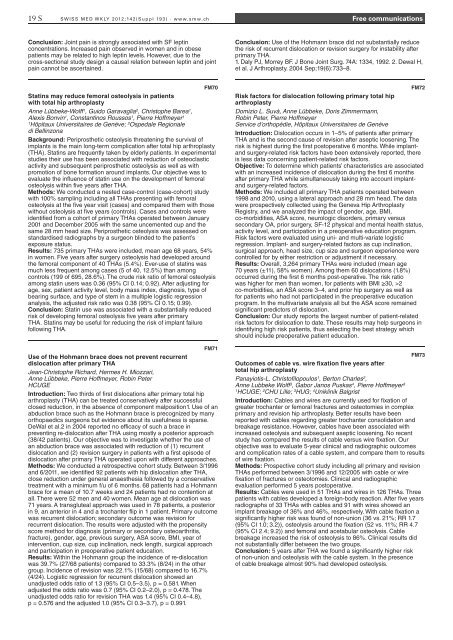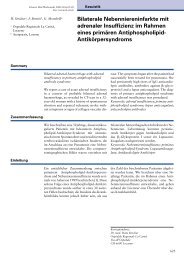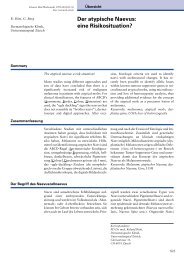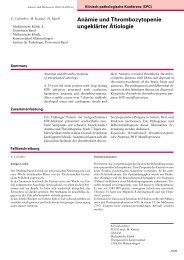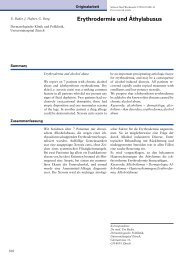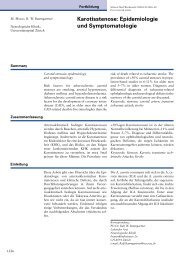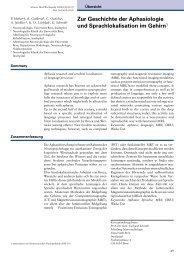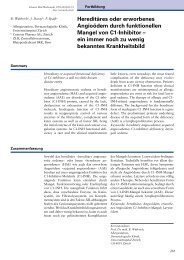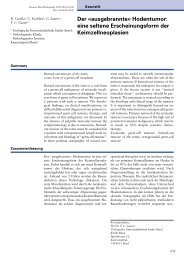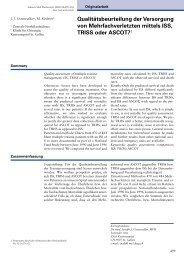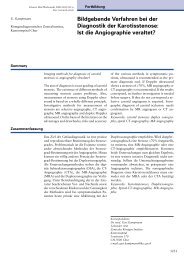SMW Supplementum 193 - Swiss Medical Weekly
SMW Supplementum 193 - Swiss Medical Weekly
SMW Supplementum 193 - Swiss Medical Weekly
You also want an ePaper? Increase the reach of your titles
YUMPU automatically turns print PDFs into web optimized ePapers that Google loves.
19 S SWiSS Med Wkly 2012;142(Suppl <strong>193</strong>) · www.smw.ch Free communications<br />
Conclusion: Joint pain is strongly associated with SF leptin<br />
concentrations. Increased pain observed in women and in obese<br />
patients may be related to high leptin levels. However, due to the<br />
cross-sectional study design a causal relation between leptin and joint<br />
pain cannot be ascertained.<br />
FM70<br />
Statins may reduce femoral osteolysis in patients<br />
with total hip arthroplasty<br />
Anne Lübbeke-Wolff1 , Guido Garavaglia2 , Christophe Barea1 ,<br />
Alexis Bonvin1 , Constantinos Roussos1 , Pierre Hoffmeyer1 1Hôpitaux Universitaires de Genève; 2Ospedale Regionale<br />
di Bellinzona<br />
Background: Periprosthetic osteolysis threatening the survival of<br />
implants is the main long-term complication after total hip arthroplasty<br />
(THA). Statins are frequently taken by elderly patients. In experimental<br />
studies their use has been associated with reduction of osteoclastic<br />
activity and subsequent periprosthetic osteolysis as well as with<br />
promotion of bone formation around implants. Our objective was to<br />
evaluate the influence of statin use on the development of femoral<br />
osteolysis within five years after THA.<br />
Methods: We conducted a nested case-control (case-cohort) study<br />
with 100% sampling including all THAs presenting with femoral<br />
osteolysis at the five year visit (cases) and compared them with those<br />
without osteolysis at five years (controls). Cases and controls were<br />
identified from a cohort of primary THAs operated between January<br />
2001 and December 2005 with the same uncemented cup and the<br />
same 28 mm head size. Periprosthetic osteolysis was assessed on<br />
standardised radiographs by a surgeon blinded to the patient’s<br />
exposure status.<br />
Results: 735 primary THAs were included, mean age 68 years, 54%<br />
in women. Five years after surgery osteolysis had developed around<br />
the femoral component of 40 THAs (5.4%). Ever-use of statins was<br />
much less frequent among cases (5 of 40, 12.5%) than among<br />
controls (199 of 695, 28.6%). The crude risk ratio of femoral osteolysis<br />
among statin users was 0.36 (95% CI 0.14; 0.92). After adjusting for<br />
age, sex, patient activity level, body mass index, diagnosis, type of<br />
bearing surface, and type of stem in a multiple logistic regression<br />
analysis, the adjusted risk ratio was 0.38 (95% CI 0.15; 0.99).<br />
Conclusion: Statin use was associated with a substantially reduced<br />
risk of developing femoral osteolysis five years after primary<br />
THA. Statins may be useful for reducing the risk of implant failure<br />
following THA.<br />
FM71<br />
Use of the Hohmann brace does not prevent recurrent<br />
dislocation after primary THA<br />
Jean-Christophe Richard, Hermes H. Miozzari,<br />
Anne Lübbeke, Pierre Hoffmeyer, Robin Peter<br />
HCUGE<br />
Introduction: Two thirds of first dislocations after primary total hip<br />
arthroplasty (THA) can be treated conservatively after successful<br />
closed reduction, in the absence of component malposition1. Use of an<br />
abduction brace such as the Hohmann brace is precognized by many<br />
orthopaedics surgeons but evidence about its usefulness is sparse.<br />
DeWal et al.2 in 2004 reported no efficacy of such a brace in<br />
preventing re-dislocation after THA using mostly a posterior approach<br />
(38/42 patients). Our objective was to investigate whether the use of<br />
an abduction brace was associated with reduction of (1) recurrent<br />
dislocation and (2) revision surgery in patients with a first episode of<br />
dislocation after primary THA operated upon with different approaches.<br />
Methods: We conducted a retrospective cohort study. Between 3/1996<br />
and 6/2011, we identified 92 patients with hip dislocation after THA,<br />
close reduction under general anaesthesia followed by a conservative<br />
treatment with a minimum f/u of 6 months. 68 patients had a Hohmann<br />
brace for a mean of 10.7 weeks and 24 patients had no contention at<br />
all. There were 52 men and 40 women. Mean age at dislocation was<br />
71 years. A transgluteal approach was used in 78 patients, a posterior<br />
in 9, an anterior in 4 and a trochanter flip in 1 patient. Primary outcome<br />
was recurrent dislocation; secondary outcome was revision for<br />
recurrent dislocation. The results were adjusted with the propensity<br />
score method for diagnosis (primary or secondary osteoarthritis,<br />
fracture), gender, age, previous surgery, ASA score, BMI, year of<br />
intervention, cup size, cup inclination, neck length, surgical approach<br />
and participation in preoperative patient education.<br />
Results: Within the Hohmann group the incidence of re-dislocation<br />
was 39.7% (27/68 patients) compared to 33.3% (8/24) in the other<br />
group. Incidence of revision was 22.1% (15/68) compared to 16.7%<br />
(4/24). Logistic regression for recurrent dislocation showed an<br />
unadjusted odds ratio of 1.3 (95% CI 0.5–3.5), p = 0.581. When<br />
adjusted the odds ratio was 0.7 (95% CI 0.2–2.0), p = 0.478. The<br />
unadjusted odds ratio for revision THA was 1.4 (95% CI 0.4–4.8),<br />
p = 0.576 and the adjusted 1.0 (95% CI 0.3–3.7), p = 0.991.<br />
Conclusion: Use of the Hohmann brace did not substantially reduce<br />
the risk of recurrent dislocation or revision surgery for instability after<br />
primary THA.<br />
1. Daly PJ, Morrey BF. J Bone Joint Surg. 74A: 1334, 1992. 2. Dewal H,<br />
et al. J Arthroplasty. 2004 Sep;19(6):733–8.<br />
FM72<br />
Risk factors for dislocation following primary total hip<br />
arthroplasty<br />
Domizio L. Suvà, Anne Lübbeke, Doris Zimmermann,<br />
Robin Peter, Pierre Hoffmeyer<br />
Service d’orthopédie, Hôpitaux Universitaires de Genève<br />
Introduction: Dislocation occurs in 1–5% of patients after primary<br />
THA and is the second cause of revision after aseptic loosening. The<br />
risk is highest during the first postoperative 6 months. While implantand<br />
surgery-related risk factors have been extensively reported, there<br />
is less data concerning patient-related risk factors.<br />
Objective: To determine which patients’ characteristics are associated<br />
with an increased incidence of dislocation during the first 6 months<br />
after primary THA while simultaneously taking into account implantand<br />
surgery-related factors.<br />
Methods: We included all primary THA patients operated between<br />
1998 and 2010, using a lateral approach and 28 mm head. The data<br />
were prospectively collected using the Geneva Hip Arthroplasty<br />
Registry, and we analyzed the impact of gender, age, BMI,<br />
co-morbidities, ASA score, neurologic disorders, primary versus<br />
secondary OA, prior surgery, SF-12 physical and mental health status,<br />
activity level, and participation in a preoperative education program.<br />
Risk factors were evaluated using uni- and multi-variate logistic<br />
regression. Implant- and surgery-related factors as cup inclination,<br />
surgical approach, head size, cup size and surgeon experience were<br />
controlled for by either restriction or adjustment if necessary.<br />
Results: Overall, 3,264 primary THAs were included (mean age<br />
70 years (±11), 58% women). Among them 60 dislocations (1.8%)<br />
occurred during the first 6 months post-operative. The risk ratio<br />
was higher for men than women, for patients with BMI ≥30, >2<br />
co-morbidities, an ASA score 3–4, and prior hip surgery as well as<br />
for patients who had not participated in the preoperative education<br />
program. In the multivariate analysis all but the ASA score remained<br />
significant predictors of dislocation.<br />
Conclusion: Our study reports the largest number of patient-related<br />
risk factors for dislocation to date. These results may help surgeons in<br />
identifying high risk patients, thus selecting the best strategy which<br />
should include preoperative patient education.<br />
FM73<br />
Outcomes of cable vs. wire fixation five years after<br />
total hip arthroplasty<br />
Panayiotis-L. Christofilopoulos1 , Berton Charles2 ,<br />
Anne Lubbeke Wolff3 , Gabor Janos Puskas4 , Pierre Hoffmeyer3 1 2 3 4 HCUGE; CHU Lille; HUG; Uniklinik Balgrist<br />
Introduction: Cables and wires are currently used for fixation of<br />
greater trochanter or femoral fractures and osteotomies in complex<br />
primary and revision hip arthroplasty. Better results have been<br />
reported with cables regarding greater trochanter consolidation and<br />
breakage resistance. However, cables have been associated with<br />
increased osteolysis and subsequent aseptic loosening. No recent<br />
study has compared the results of cable versus wire fixation. Our<br />
objective was to evaluate 5-year clinical and radiographic outcomes<br />
and complication rates of a cable system, and compare them to results<br />
of wire fixation.<br />
Methods: Prospective cohort study including all primary and revision<br />
THAs performed between 3/1996 and 12/2005 with cable or wire<br />
fixation of fractures or osteotomies. Clinical and radiographic<br />
evaluation performed 5 years postoperative.<br />
Results: Cables were used in 51 THAs and wires in 126 THAs. Three<br />
patients with cables developed a foreign-body reaction. After five years<br />
radiographs of 33 THAs with cables and 91 with wires showed an<br />
implant breakage of 36% and 46%, respectively. With cable fixation a<br />
significantly higher risk was found of non-union (36 vs. 21%; RR 1.7<br />
(95% CI 1.0; 3.2)), osteolysis around the fixation (52 vs. 11%; RR 4.7<br />
(95% CI 2.4; 9.2)) and femoral and acetabular osteolysis. Cable<br />
breakage increased the risk of osteolysis to 86%. Clinical results did<br />
not substantially differ between the two groups.<br />
Conclusion: 5 years after THA we found a significantly higher risk<br />
of non-union and osteolysis with the cable system. In the presence<br />
of cable breakage almost 90% had developed osteolysis.


